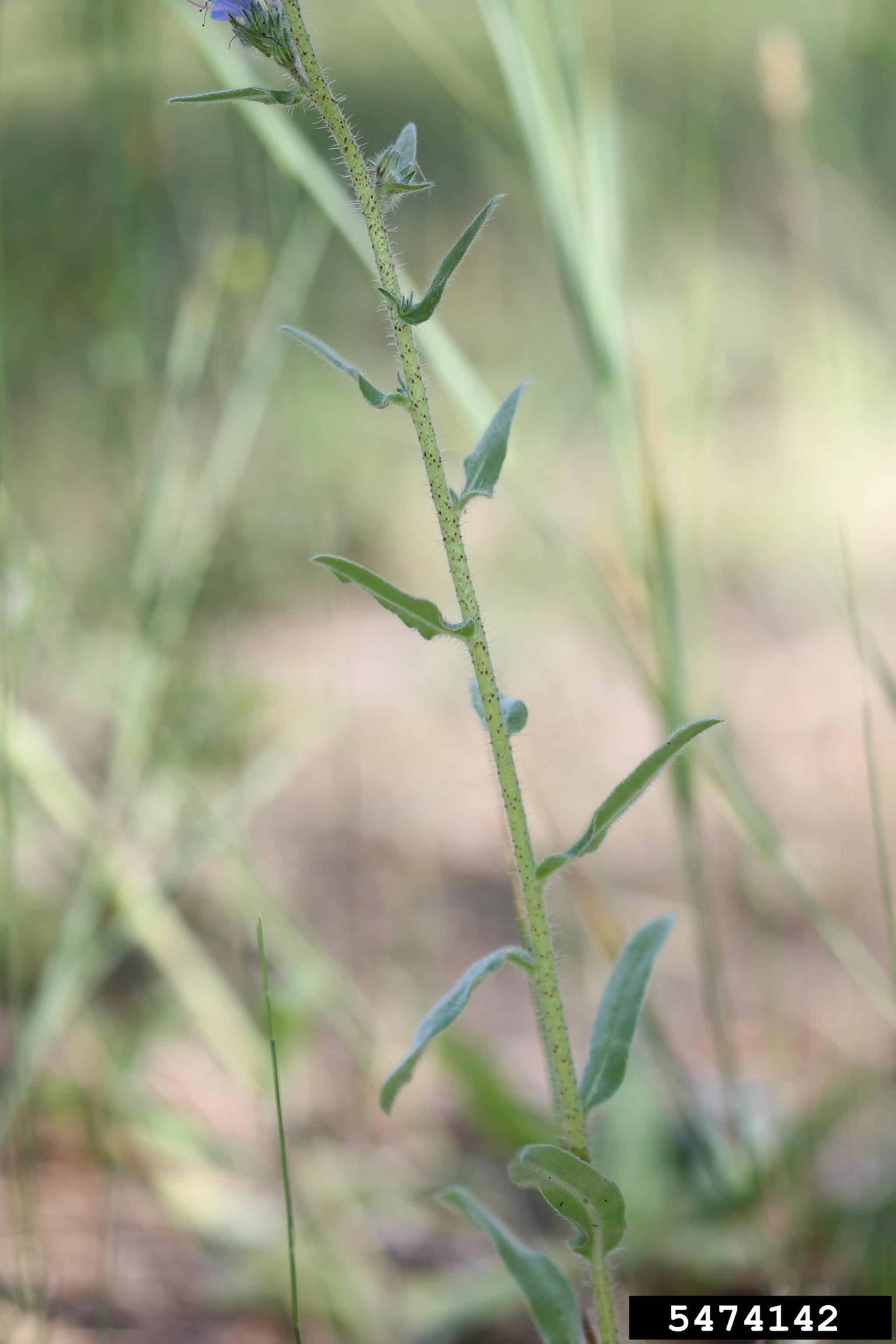Echium vulgare
Explore More :
Explore plus :
Overview
Aperçu
Regulation :
Remarques Réglementation:
- Quarantine lists of countries e.g. Mexico *may be updated without notice
Regulation Notes:
On quarantine lists of countries e.g. Mexico*.
*Quarantine lists of countries may be updated without notice.
Distribution :
Répartition :
This species is native to Eurasia and widely naturalized elsewhere, including Africa, Australasia, and North and South America (USDA-ARS 2017). It is widespread in the United States (USDA-NRCS 2017).
Habitat and Crop Association :
Habitat et Cultures Associées :
This species prefers dry soils, particularly those derived from limestone or dolomite parent material, in pastures, rangelands, old fields, roadsides and highly disturbed areas (Klemow et al. 2002; Darbyshire 2003).
Economic Use, cultivation area, and Weed Association :
Utilisation économique, zone de culture et association de mauvaises herbes :
Duration of Life Cycle :
Durée du cycle vital:
Biennial or short-lived perennial
Dispersal Unit Type :
Type d’unité de dispersion :
Nutlet
General Information
RENSEIGNEMENTS GÉNÉRAUX
Blueweed is common throughout Canada except in the far north and the prairies. It is not competitive with crops but serves as an alternate host for fungal pathogens such as wheat rust (Puccinia spp.) and contains pyrrolizidine alkaloids that are toxic to livestock. Plants have stiff hairs that can cause contact dermatitis (Klemow et al. 2002; Darbyshire 2003).
.
Echium vulgare plant (Robert Vidéki, Doronicum Kft., Bugwood.org)
Identification
Identification
-
Nutlet
Size
- Nutlet length: 2.3 – 3.0 mm (average 2.6 mm); width: 1.5 – 2.1 mm (average: 1.8 mm)
Shape
- Nutlet is polygonal-shaped with a flattened broad end
Surface Texture
- Nutlet is covered with small granules, large warty tubercles , and small ridges
- A prominent ridge runs down the middle of one side
Colour
- Slightly shiny medium brown nutlet, dark brown between the tubercles and ridges
- The point of attachment is dull brown
Other Features
- The point of attachment is roughened with 2 tubercles

Blueweed (Echium vulgare) nutlets






Identification Tips
CONSEILS POUR L’IDENTIFICATION
Additional Botany Information
AUTRES RENSEIGNEMENTS BOTANIQUES

Echium vulgare flowers (Rob Routledge, Sault College, Bugwood.org)



Similar Species
ESPÈCES SEMBLABLES
Similar species are based on a study of seed morphology of various species, and those with similar dispersal units are identified. The study is limited by physical specimen and literature availability at the time of examination, and possibly impacted by the subjectivity of the authors based on their knowledge and experience. Providing similar species information for seed identification is to make users aware of similarities that could possibly result in misidentification.
Buglossoides arvensis (corn gromwell)
Buglossoides arvensis nutlets have a similar tuberculate surface and a dull, brown point of attachment.
Buglossoides arvensis nutlets are generally larger (average length: 3.2 mm; average width: 1.9 mm), a teardrop shape, white or light-brown coloured, a prominent central ridge, and a rounded point of attachment.
Click to select species
Cliquez pour sélectionner les espèces

Buglossoides arvensis
Comparison Window
Fenêtre de comparaison
MAIN SPECIES
ESPÈCES PRINCIPALES
Echium vulgare

Echium vulgare
Boraginaceae
Blueweed (Echium vulgare) nutlets
MAIN SPECIES
ESPÈCES PRINCIPALES
Echium vulgare

Echium vulgare
Boraginaceae
Blueweed (Echium vulgare) nutlets
MAIN SPECIES
ESPÈCES PRINCIPALES
Echium vulgare

Echium vulgare
Boraginaceae
Blueweed (Echium vulgare) nutlet
MAIN SPECIES
ESPÈCES PRINCIPALES
Echium vulgare

Echium vulgare
Boraginaceae
Blueweed (Echium vulgare) nutlet
MAIN SPECIES
ESPÈCES PRINCIPALES
Echium vulgare

Echium vulgare
Boraginaceae
Blueweed (Echium vulgare) nutlet; close up of truncate base
MAIN SPECIES
ESPÈCES PRINCIPALES
Echium vulgare

Echium vulgare
Boraginaceae
Blueweed (Echium vulgare) nutlet; close up of truncate base
SIMILAR SPECIES
ESPÈCES SEMBLABLES
Buglossoides arvensis

Buglossoides arvensis
Boraginaceae
Corn gromwell (Buglossoides arvensis) nutlets
SIMILAR SPECIES
ESPÈCES SEMBLABLES
Buglossoides arvensis

Buglossoides arvensis
Boraginaceae
Corn gromwell (Buglossoides arvensis) nutlets
SIMILAR SPECIES
ESPÈCES SEMBLABLES
Buglossoides arvensis

Buglossoides arvensis
Boraginaceae
Corn gromwell (Buglossoides arvensis) nutlet
SIMILAR SPECIES
ESPÈCES SEMBLABLES
Buglossoides arvensis

Buglossoides arvensis
Boraginaceae
Corn gromwell (Buglossoides arvensis) nutlet
SIMILAR SPECIES
ESPÈCES SEMBLABLES
Buglossoides arvensis

Buglossoides arvensis
Boraginaceae
Corn gromwell (Buglossoides arvensis) nutlet
Need ID Help?
Besoin d’aide pour l’identification?
Reference(s)
Référence(s)
Darbyshire, S. J. 2003. Inventory of Canadian Agricultural Weeds. Agriculture and Agri-Food Canada, Research Branch. Ottawa, ON.
Global Biodiversity Information Facility (GBIF) Secretariat. 2022. https://doi.org/10.15468/39omei Accessed via https://www.gbif.org/species/2925892 Accessed December 29, 2022.
Klemow, K. M., Clements, D. R., Threadgill, P. F. and Cavers, P. B. 2002. The biology of Canadian weeds. 116. Echium vulgare L. Canandian Journal of Plant Science 82: 235–248.
U.S. Department of Agriculture-Agricultural Research Services (USDA-ARS). 2017. Germplasm Resources Information Network (GRIN), https://npgsweb.ars-grin.gov/gringlobal/taxon/taxonomysearch Accessed April 25, 2017.
U.S. Department of Agriculture-Natural Resources Conservation Service (USDA-NRCS). 2017. The PLANTS Database. National Plant Data Team, Greensboro, NC USA. https://plants.usda.gov/home Accessed April 25, 2017.
U.S. Department of Agriculture-Natural Resources Conservation Service (USDA-NRCS). 2022. The PLANTS Database. National Plant Data Team, Greensboro, NC USA. http://plants.usda.gov Accessed December 29, 2022.




